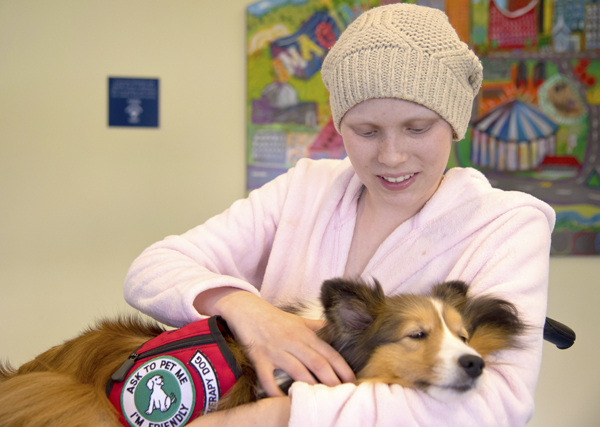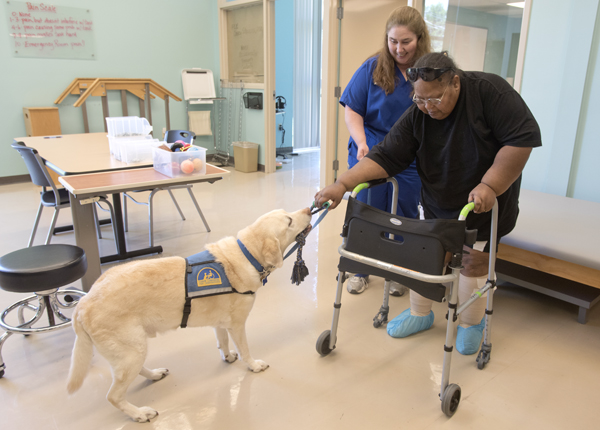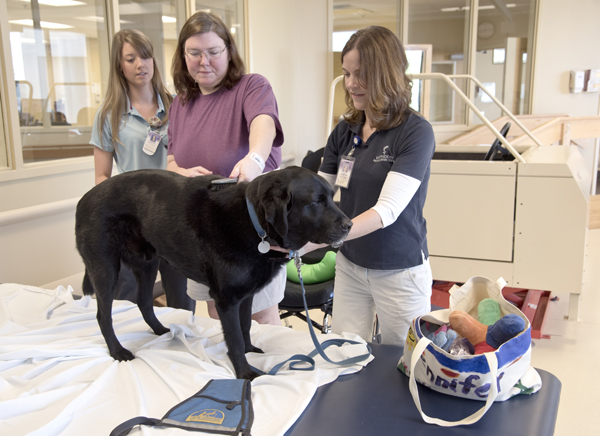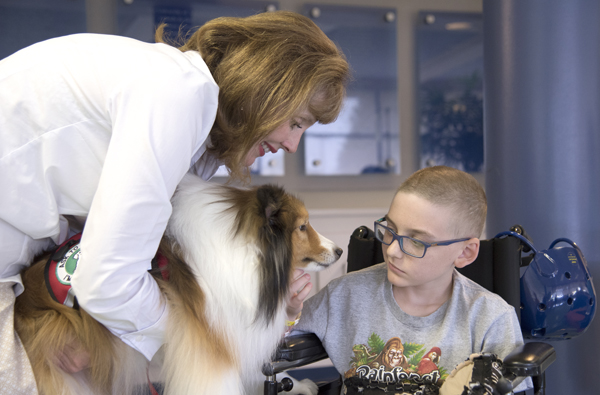Teacher's pets: Dogs help therapists mend bodies, hearts

It may not be a magic bullet or the fountain of youth, but with it, patients on walkers have stood longer; stroke victims in recovery have walked farther; children in hospitals have smiled bigger.
That's what happens when they meet the highly trained, four-legged whizzes employed in animal-assisted therapy or its close relative, pet therapy - although their full-time job is being a dog.
"When I first started doing this," said Susan Raphael, a volunteer pet-therapy handler, "people would say, 'Therapy for a dog? I've never heard of that.'"
Actually, dog psychologists exist. But that's another story. This is, more or less, the story of Lanny, a white Labrador Retriever; Lyla, a Sheltie; and Puma, a black part-Lab, part-Golden Retriever, along with their handlers: Gina McRae, Jenn Sivak and Raphael, respectively.
They can be found brightening up the lobbies or clinics of the University Rehabilitation Center (URC) building, Methodist Rehabilitation Center or Batson Children's Hospital.
Without them, patients trying to restore their limbs and muscles - and, sometimes, their emotions - perform certain tasks. With them, they've been known to perform wonders.
Lanny

The expression on the dog's face is familiar. It's the look lottery winners get when they're about to receive the check.
But, instead of money, Lanny's about to get a ball thrown at him. The thrower is Christine Porter, one of URC's patients.
Under the direction of Gina McRae, her physical therapist, Porter is on her feet behind her wheeled walker, poised to fling the ball while trying to remain erect and maintain her balance. She could do this without Lanny there to bring it back, but it wouldn't be as much fun.
McRae and Lanny are a "facility team;" as such, they may visit schools, nursing homes, funeral homes and more. Some call on law enforcement agencies to comfort abused children.
Physical therapists, occupational therapists and recreational therapists are among those who can use animal-assisted therapy on the job.
"For me, it's the best of both worlds," McRae said. "I get to help people and bring my dog to work at the same time."
As a PT, McRae works with patients, including stroke victims, to achieve certain goals, such as improving upper extremity movement, by asking them to groom Lanny.
Related to animal-assisted therapy is pet therapy, wherein patients or residents of hospitals and nursing homes, for example, may prosper emotionally from a visit with an understanding companion. Lanny does not judge.
"People have told me they feel better just by having him in the room," McRae said. "They just like looking at him."
Lanny underwent months of training from California-based Canine Companions for Independence (CCI), which prefers Labs or Golden Retrievers or a mix of the breeds; that's because of their size, graciousness and teachability, McRae said.
McRae, too, spent two weeks in rotation at CCI with several dogs, until she was eventually paired with Lanny.
"I worked with a lot of geriatric patients at the time," she said. "Lanny's temperament is suitable for that. He was more easily distracted around small children, but now that he's older, he's a little less goofy."
Known then as "lovable, laidback Lanny," he graduated from CCI when he was 2; now 11 ½, he and McRae have been together since November 2005.
"Lanny is a tool in my toolbox," said McRae, whose patients primarily are trying to overcome traumatic brain injuries or strokes. "He loves to come to work, and he will as long as he can get in the car."
Among the 40 or so different commands Lanny knows is "tug" - he uses his teeth to tug a rope attached to the handle of a drawer or door, opening it for someone who can't. "Tug" is also a prompt for Lanny to play tug-of-war to help patients concentrate on their balance.
"People will work longer with Lanny and focus more," McRae said. "Some don't even notice they're tiring out."
That seems to be the case with Porter, who is easily winded. Still, she plays fetch with Lanny for several minutes before asking for a break. Lanny's face falls.
Some time ago, McRae said, she was the PT for a young girl whose spinal cord injury made it tough for her to sit up. Her limit was one minute.
"But the first time Lanny visited her, she sat on a mat with him for 30."
Puma

It's true that Puma has been to prison, but it's also true that he got in because of good behavior.
During his training as a puppy, the Lab/Golden mix did time at a Montana minimum security prison for 1½ years, helping inmates improve their job-related and social skills while they taught Puma the skills and 50 or so basic commands he would need later as a facility dog.
Today, about eight years later, he's Methodist's official facility dog, the latest easy-going successor to MRC's first facility dog, a beloved Golden Retriever named Fair.
"He's the only employee we let nap on the job," said Susan Christensen, director of public and media relations.
Like Lanny, Puma is a product of CCI, which paired him with Jenn Sivak, an OT.
"For his final exam, he had to go to a mall in Orlando for a series of tests - food was dropped in front of him, and he had to leave it alone at the handler's command," Sivak said.
He also had to follow a "patient," even after his handler had dropped his leash. He learned to not take up too much space in an elevator.
Whenever he does enter an occupied elevator with Sivak, "people say hi to him first," she says.
Loud noises don't startle him, and he doesn't bark - not even at doorbells or other dogs. When he's not working, he spreads out like a soft, black rug on the floor, where he seems to move as perceptibly as the hour hand of a clock.
"That's great in a lot of ways," Sivak said, "but sometimes it takes a while to rev him up."
Puma and his contemporaries are not for everyone. Patients must like dogs before one can do them any good - which is often the case.
"Dog lovers may show a level of interaction with Puma that they don't with humans," Sivak said. "People who have trouble speaking because of a stroke may reach out to him and try to say 'dog.'"
Stroke patient Mandy Owens has no trouble communicating, but she is trying to strengthen her left arm, recover more hand control and improve her balance.
While standing up, Owens brushes up on all these skills by brushing Puma. A three-dog owner herself, she looks into Puma's sad-friendly eyes and says, "I miss my babies at home."
Lyla

She's named for a character from the TV series "Friday Night Lights" - Lyla, the All-American cheerleader.
Although her breed originated outside the United States, in Scotland's Shetland Islands, the 5-year-old Shetland Sheepdog, or Sheltie, is still a golden girl, as far as children at Batson are concerned.
Often, Lyla doesn't have to go to them; they come to her.
During Lyla's appearance this month at the children's hospital, a young boy strolling through the lobby with his mother stops in his tracks at the sight of the expectant therapy dog, who looks like a diva waiting for her close-up.
"Your dog's nice," he says to Susan Raphael. "Does she have a tongue?"
Raphael assures him that the dog has one and knows how to use it, adding that Lyla is a herder by instinct. "She'll herd your bicycle or your vacuum cleaner," she says.
Lyla will also help you collect your emotions. Trained as a disaster-stress relief dog by New Jersey-based Therapy Dog International (TDI), she can comfort victims of traumatic events. In 1995, about 20 TDI dogs responded after the deadly bombing in Oklahoma City.
TDI takes all breeds of dogs, including some adopted from shelters, as long as they like humans and other dogs and can easily adjust to people using crutches, wheelchairs, etc. Therapy dogs, too, must pass tests.
Raphael, certified as a volunteer handler by TDI, also takes Lyla to adult daycares, public libraries and a retirement home. She's partial to Shelties.
"They make wonderful family dogs and are good with children," she says.
Putting Lyla in front of a child is like placing a podium in front of a politician. This is especially true for Dallas Jordan, 14, of Pearl, during her latest encounter with Lyla in Batson's lobby.
Seated in a wheelchair while recuperating from hip replacement surgery related to another illness, Dallas says she had been feeling "stuck inside four walls all day.
"So I like coming down here," she says, while holding Lyla's head in her lap. An only child, Dallas has an only dog - a black Lab named Buck. "I love animals," she says. "I LOVE animals."
A few feet away, Dallas' mom, Kim Jordan, says to Raphael, "This has meant so much to her."
Raphael has been regular at Batson for more than a decade, teaming up with her first Shelties, Molly and Susie, in 2004. Now, she and Lyla visit with the children the second Wednesday of every month, Raphael says.
"And you always leave believing that somebody is feeling better today."


